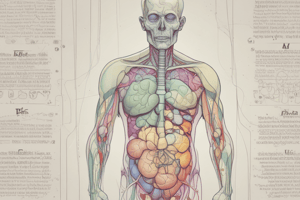Podcast
Questions and Answers
What condition is often caused by excessive vomiting?
What condition is often caused by excessive vomiting?
- Metabolic Acidosis
- Metabolic Alkalosis (correct)
- Lactic Acidosis
- Respiratory Alkalosis
What is the primary reason for the increase in plasma bicarbonate during metabolic alkalosis?
What is the primary reason for the increase in plasma bicarbonate during metabolic alkalosis?
- Inadequate proton excretion (correct)
- Increase in lactate production
- Excessive proton excretion
- Decrease in ketone bodies
Which process is described as a chemical change?
Which process is described as a chemical change?
- Burning of hydrocarbons (correct)
- Dissolving salt in water
- Evaporating alcohol
- Melting ice
What is a characteristic of a physical change in matter?
What is a characteristic of a physical change in matter?
Which of the following is a consequence of kidney failure in terms of acid-base balance?
Which of the following is a consequence of kidney failure in terms of acid-base balance?
What defines matter in the context of chemistry?
What defines matter in the context of chemistry?
Which of the following processes is NOT a metabolic process leading to acid-base imbalance?
Which of the following processes is NOT a metabolic process leading to acid-base imbalance?
What role does energy play in chemical reactions?
What role does energy play in chemical reactions?
What is the result of adding $1.95 \times 10^{-2}$ and $2.8 \times 10^{-3}$?
What is the result of adding $1.95 \times 10^{-2}$ and $2.8 \times 10^{-3}$?
What is the product of $7.40 \times 10^{5}$ and $3.12 \times 10^{9}$?
What is the product of $7.40 \times 10^{5}$ and $3.12 \times 10^{9}$?
When dividing $1.62 \times 10^{-4}$ by $7.94 \times 10^{7}$, what is the correct answer?
When dividing $1.62 \times 10^{-4}$ by $7.94 \times 10^{7}$, what is the correct answer?
Which of the following is NOT a basic unit of measurement for mass?
Which of the following is NOT a basic unit of measurement for mass?
What metric prefix corresponds to $10^{-3}$?
What metric prefix corresponds to $10^{-3}$?
Which of the following metric prefixes indicates a factor of $10^{9}$?
Which of the following metric prefixes indicates a factor of $10^{9}$?
Which of the following temperature scales is commonly used in scientific measurements?
Which of the following temperature scales is commonly used in scientific measurements?
In measurements, what are the two parts that constitute a measurement?
In measurements, what are the two parts that constitute a measurement?
What is the primary role of a weak acid in a buffer solution?
What is the primary role of a weak acid in a buffer solution?
Which property of water contributes to its ability to support life as a solvent?
Which property of water contributes to its ability to support life as a solvent?
What characterizes a strong acid compared to a weak acid?
What characterizes a strong acid compared to a weak acid?
How do hydrophobic interactions primarily occur?
How do hydrophobic interactions primarily occur?
Which statement about hydrogen bonds in water is accurate?
Which statement about hydrogen bonds in water is accurate?
What is an example of a property that gives water a high heat capacity?
What is an example of a property that gives water a high heat capacity?
In a chemical reaction involving acids and bases, what role does a base play?
In a chemical reaction involving acids and bases, what role does a base play?
What defines amphipathic molecules, such as micelles, in an aqueous environment?
What defines amphipathic molecules, such as micelles, in an aqueous environment?
Flashcards are hidden until you start studying
Study Notes
Lactic Acid and Metabolic Effects
- Lactic acid accumulation occurs during intense workouts.
- Increased production of ketone bodies can also occur during strenuous exercise.
- Loss of bicarbonate due to diarrhea can affect acid-base balance in the body.
- Kidney failure leads to reduced proton excretion, contributing to acidosis.
Metabolic Alkalosis
- Elevated plasma bicarbonate levels indicate metabolic alkalosis.
- Commonly caused by excessive vomiting or proton loss.
Matter, Energy, and Chemistry
- Everything around us is composed of chemicals, influencing daily experiences.
- The universe consists of matter, energy, and empty space; matter has mass and occupies space.
- Chemistry focuses on the structure, properties, and transformations of matter.
- Chemical changes involve energy altering matter (e.g., burning hydrocarbons).
- Physical changes alter the state's appearance without changing the identity of the matter.
Scientific Notation Examples
- Addition of 1.95x10^-2 and 2.8x10^-3 results in 2.23x10^-2.
- Multiplication of 7.40x10^5 and 3.12x10^9 yields 2.31x10^14.
- Division of 1.62x10^-4 by 7.94x10^7 equals 2.04x10^-12.
Importance of Measurements
- Measurements are integral to daily life (e.g., recipes, distances, water volumes).
- Each measurement consists of a number and a unit.
Measurement Units
- Length: Meter
- Volume: Liter
- Mass: Gram
- Time: Seconds or Hours
- Temperature: Celsius
Common Metric Prefixes
- Giga – 10^9
- Mega – 10^6
- Kilo – 10^3
- Deci – 10^-1
- Centi – 10^-2
- Milli – 10^-3
- Micro – 10^-6
- Nano – 10^-9
- Pico – 10^-12
Water and Its Properties
- Water is a polar molecule, allowing hydrogen bonds to form between molecules.
- Constant breakage and formation of bonds lead to water having approximately 2.3 hydrogen bonds and ice having 4.
Non-Covalent Interactions
- Ionic Bonds: Interaction between positively and negatively charged molecules.
- Electrostatic Interactions: Rely on the attraction/repulsion of ions.
- Hydration of ions occurs in solution.
Types of Non-Covalent Bonds
- Hydrogen Bonds: Seen in water, amines, alcohols, and carboxylic acids.
- Van der Waals Forces: Result from unequal electron distribution.
- Hydrophobic Interactions: Occur in aqueous environments as hydrophobic molecules coalesce.
Water: The Universal Solvent
- Water dissolves ionic and polar compounds and interacts with amphipathic molecules forming micelles.
Unique Properties of Water
- Remains liquid at normal temperatures.
- High boiling and melting points.
- Significant heats of fusion and vaporization.
- High heat capacity and surface tension.
Acids and Bases
- Acids function as proton donors, while bases act as proton acceptors.
- Strong acids and bases dissociate completely; weak ones do not, creating conjugate pairs.
Buffers
- Buffers consist of weak acids and conjugate bases.
- They stabilize pH by absorbing excess protons or hydroxide ions, resisting significant pH changes.
Studying That Suits You
Use AI to generate personalized quizzes and flashcards to suit your learning preferences.





